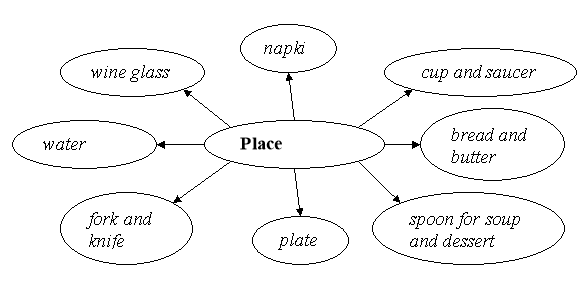Конспект уроку «Приготування їжі». 7 клас
Topic. Приготування їжі. Сервірування столу.
Objectives:
- to present and practice new words;
- to role play a situation;
- to develop students’ reading skills.
Equipment: textbooks, handouts.
The Course of the Lesson
I. The Beginning of the Lesson.
1. Organizing the class for the lesson.
T.: Do you like cooking? What is your favourite dish? What cooking equipment do you use while cooking? What things does your mother use while cooking?
T.: Today we are going to talk about the way we lay the table and cook our meals. We’ll be able to tell each other the recipes of your favourite dishes. You know that there is a saying “You are what you eat”. What do you think it means?
P.: I think it means …
T.: By the way, what did you have for breakfast today?
P.: I had … for breakfast.
2. Warm-up activities.
T.: Now, look at the blackboard and give the answers to my question: “What do you need?”
- To make coffee I need …
- To make tea I need …
- To fry an egg I need …
- To eat my food I need …
- To drink some water I need …
- To make my dinner in just two minutes I need …
II. The Main Body of the Lesson.
3. Homework check-up.
T.: Your homework for today was to speak about your householding duties. What do you usually do about the house? How often do you help your mother about the house? Can you make tea? How do you do it?
4. Presenting new material.
T.: Today we are going to learn how we set out the table. On the blackboard you can see the things we put on the table when we have breakfast, dinner or supper.

T.: Do you help your mother to lay the table? How often do you lay the table? What do you usually put on the table? Do you like cooking? What do you usually cook?
Now look at the blackboard and read the list of verbs for preparing and cooking food and match them with the food words:
Verbs Food
- Bake a) Chicken
- Boil b) Turkey
- Chop c) Fish
- Cut d) Banana
- Fry e) Onion
- Grill f) Potato
- Peel g) Meat
- Roast h) Lemon
- Slice i) Carrot
- Squeeze j) Cake
5. Practising new material.
T.: Now you are going to learn the way we make a tomato and cheese sandwich. Your task is to fill in the words from the box and read the recipe. (Ex. 3 p. 60 “English 7” O. Karpiuk).
put (x3) cut eat slice(x2)
Tomato and Cheese Sandwich
… to open the bread roll,
… the tomatoes.
… the cheese.
… tomato slices on the bread.
… some cheese on top.
… the top of the bread roll on top.
Now … your sandwich. It’s delicious!
T.: I’ll read you the recipe of my favourite dish. Your task is to guess what my favourite dish is.
“Oil the pan. Put the flour and salt into a bowl. Add some butter, milk and mix. Put the dough into the oiled pan. Add sliced tomatoes, cheese and ham. Bake for about 15 minutes in a microwave oven. Enjoy your …”(pizza)
T.: Do you cook sandwich? What are the ingredients of it? Now you will listen to the story about the sandwich. Be ready to answer the question: “How did the sandwich come to the world?”
How the Sandwich Came to the World
In 1762, there was a very famous English politician. Everybody knew about him because he enjoyed playing cards very much. One night he stayed at the card table for 24 hours. And he ate nothing but slices of bread with pieces of meat inside. His name was John Sandwich. The English name for a sandwich comes from this man.
Sandwiches were great favourites in Victorian England. It was the custom to “take” afternoon tea at about four o’clock. Many rich families ate sandwiches at this time.
Cucumber sandwiches were very popular. The servants always cut the edge of the bread, so the sandwiches were very small and delicate.
Sandwiches are less elegant now and often much bigger.
The English eat millions of sandwiches every day. They are a typical “snack” meal because they are easy and quick to prepare. You can buy sandwiches if you don’t want to make them yourself. There are thousands of “sandwiches bars” and cafés and even some restaurants that sell them.
T.: Some sentences are true according to the text, some sentences are false and some information is not given in the text. Try to decide.
- Sandwich is the name of a person.
- A well-known politician invented sandwiches.
- His hobby was playing cards.
- He ate sandwiches every day.
- His wife liked sandwiches, too.
- In Victorian English families ate sandwiches during the tea time.
- Cucumber and tomato sandwiches were very popular.
- Sandwiches were very popular in France, too.
- Sandwiches are smaller now than they were before.
- If you can’t make sandwiches, you can buy them.
- Sandwiches are easy to cook.
- Sandwiches can be hot.
6. Checking up the students’ comprehension of the lesson.
T.: Imagine you are arranging a party. One student is doing to cook some dishes and the second one is going shopping. Using the following expressions role-play the situation.
First student (e.g. Ann): I need some…
I am going to cook…
No, … is enough.
You may buy a …
Second student(e.g. Nick): Do you need some …
Do you think it will be enough?
What about some…?
Why don’t we buy a …?
Listen and repeat after me.
 It’s one o’clock. I’m at the shop waiting for Nick.
It’s one o’clock. I’m at the shop waiting for Nick.
 It’s five past one. I have been waiting for five minutes.
It’s five past one. I have been waiting for five minutes.
 It’s ten past one. I have been waiting for ten minutes already.
It’s ten past one. I have been waiting for ten minutes already.
What have I been doing? I have been waiting.
 It’s half past one. Ann is at home she is waiting for Nick.
It’s half past one. Ann is at home she is waiting for Nick.
 It’s twenty-five to two. Ann has been waiting for Nick for five minutes.
It’s twenty-five to two. Ann has been waiting for Nick for five minutes.
 It’s twenty to two. Ann has been waiting for ten minutes.
It’s twenty to two. Ann has been waiting for ten minutes.
What has Ann been doing? She has been waiting.
We have the new grammar construction.
III. The End of the Lesson.
7. Homework setting.
T.: You hometask is to be ready to speak on the way you lay the table for dinner and learn new vocabulary.
8. Summing up.
T.: Well, we have learnt many new things today. What did you like best of all? You did such a wonderful job!


про публікацію авторської розробки
Додати розробку
